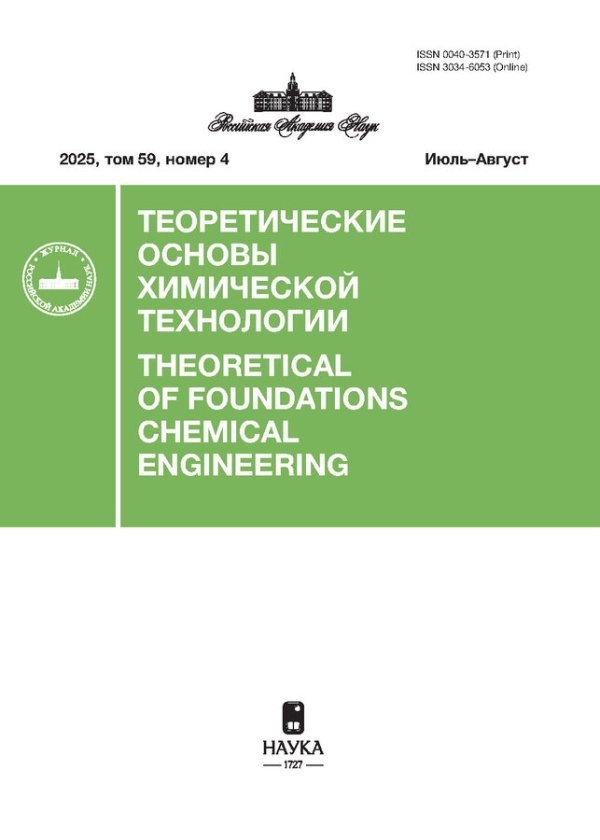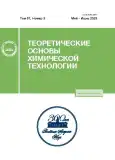Kinetics of Ultrasonic Dissolution of Metal Oxide Powder for Different Spatial Combinations of the Cavitation Region and Eckart Acoustic Flow
- Authors: Gradov O.M.1, Zinov’eva I.V.1, Zakhodyaeva Y.A.1, Voshkin A.A.1
-
Affiliations:
- Institute of General and Inorganic Chemistry, N.S. Kurnakov Russian Academy of Sciences
- Issue: Vol 57, No 3 (2023)
- Pages: 273-283
- Section: Articles
- Published: 01.05.2023
- URL: https://journals.rcsi.science/0040-3571/article/view/138463
- DOI: https://doi.org/10.31857/S0040357123030065
- EDN: https://elibrary.ru/RLPKGQ
- ID: 138463
Cite item
Full Text
Abstract
The features of the impact of acoustic flow and cavitation created by a traveling ultrasonic wave, which can be used for efficient dissolution of a metal oxide powder, are considered. On the basis of a simplified scheme, which, nevertheless, takes into account all the essential features of the phenomenon under study, exact expressions are obtained for all parameters of stationary vortex motion and cavitation, which fully meet the requirements for proper control of the reaction course. Equations are derived that describe the dissolution kinetics for two typical regimes: developed cavitation and pre-cavitation state. Expressions are found for the time to completion of the process. On the example of these two most typical types of reaction, the conditions are formulated under which it will be possible to fully satisfy the solution of the technological challenges. The methods for the optimal application of the ultrasonic dissolution scheme are presented and those features of its formation that make it possible to control the process are noted. The performed calculations make it possible to select and accurately implement the scheme of acoustic stimulation of dissolution which best corresponds to the expected output results and other processing features.
Keywords
About the authors
O. M. Gradov
Institute of General and Inorganic Chemistry, N.S. Kurnakov Russian Academy of Sciences
Email: lutt.plm@igic.ras.ru
Moscow, Russia
I. V. Zinov’eva
Institute of General and Inorganic Chemistry, N.S. Kurnakov Russian Academy of Sciences
Email: lutt.plm@igic.ras.ru
Moscow, Russia
Yu. A. Zakhodyaeva
Institute of General and Inorganic Chemistry, N.S. Kurnakov Russian Academy of Sciences
Email: lutt.plm@igic.ras.ru
Moscow, Russia
A. A. Voshkin
Institute of General and Inorganic Chemistry, N.S. Kurnakov Russian Academy of Sciences
Author for correspondence.
Email: lutt.plm@igic.ras.ru
Moscow, Russia
References
- Narayana K.L., Swamy K.M., Rao K.S., Murty J.S. Leaching of Metals from Ores with Ultrasound // Miner. Process. Extr. Metall. Rev. 1997. V. 16(4). P. 239.
- Lei C., Aldous I., Hartley J.M., Thompson D.L., Scott S., Hanson R., Anderson P.A., Kendrick E., Sommerville R., Ryder K.S., Abbott A.P. Lithium ion battery recycling using high-intensity ultrasonication // Green Chem. 2021. V. 23. P. 4710.
- Sandilya D.K., Kannan A. Intensification of the Dissolution of a Sparingly Soluble Solid from a Spinning Disk in the Presence of Power Ultrasound // Ind. Eng. Chem. Res. 2020. V. 50(23). P. 13083.
- Sandilya D.K., Kannan A. Intensification of the Dissolution of a Sparingly Soluble Solid from a Spinning Disk in the Presence of Power Ultrasound // Ind. Eng. Chem. Res. 2020. V. 50(23). P. 13083.
- Xin W., Srinivasakannan C., Xin-hui D., Jin-hui P., Da-jin Y., Shao-hua J. Leaching kinetics of zinc residues augmented with ultrasound // Sep. Purif. Tech. 2013. V. 115. P. 66.
- Avvaru B., Roy S.B., Chowdhury S., Hareendran K.N., Pandit A.B. Enhancement of the Leaching Rate of Uranium in the Presence of Ultrasound // Ind. Eng. Chem. Res. 2006. V. 45(22). P. 7639.
- Li X., Zhang J., Yang D. Determination of Antiscaling Efficiency and Dissolution Capacity for Calcium Carbonate with Ultrasonic Irradiation // Ind. Eng. Chem. Res. 2012. V. 51(27). P. 9266.
- Gui Q., Khan M.I., Wang S., Zhang L. The ultrasound leaching kinetics of gold in the thiosulfate leaching process catalysed by cobalt ammonia // Hydrometallurgy. 2020. V. 196. P. 105426.
- Gradov O.M., Voshkin A.A., Zakhodyaeva Y.A. Estimating the parameters of ultrasonically induced mass transfer and flow of liquids in the pseudomembrane method // Chem. Eng. Process. 2017. V. 118. P. 54.
- Градов О.М., Зиновьева И.В., Заходяева Ю.А., Вошкин А.А. Кинетика растворения порошка LiCoO2 в глубоком эвтектическом растворителе хлорид холина–сульфосалициловая кислота под воздействием ультразвука // Теор. осн. хим. техн. 2022. Т. 56. № 6. С. 705–711.
- Gradov O.M., Zakhodyaeva Y.A., Voshkin A.A. Breakup of immiscible liquids at the interface using high-power acoustic pulses // Chem. Eng. Process. 2018. V. 131. P. 125.
- Gradov O.M., Zakhodyaeva Y.A., Zinov’eva I.V., Voshkin A.A. Some Features of the Ultrasonic Liquid Extraction of Metal Ions // Molecules. 2019. V. 24(19). P. 3549.
- Gradov O.M., Zakhodyaeva Yu.A., Zinov’eva I.V., Voshkin A.A. Ultrasonic Intensification of Mass Transfer in Organic Acid Extraction. Processes. 2021. V. 9(1). P. 15.
- Gradov O.M., Zakhodyaeva Y.A., Voshkin A.A. Dynamics of Mass Transfer through the Interface between Immiscible Liquids under the Resonance Effect of Ultrasound // Theor. Found. Chem. Eng. 2020. V. 54. P. 1148.
- John J.J., De Houwer V., Van Mechelen D., Van Gerven T. Effect of ultrasound on leaching of lead from landfilled metallurgical residues // Ultrasonics Sonochemistry. 2020. V. 69. Article 105239.
- Xiao J., Yuan J., Tian Z., Yang K., Yao Z., Yu B., Zhang L. Comparison of ultrasound-assisted and traditional caustic leaching of spent cathode carbon (SCC) from aluminum electrolysis // Ultrasonics Sonochemistry. 2018. V. 40. P. 21–29.
- Lei C., Aldous I., Hartley J.M., Thompson D.L., Scott S., Hanson R., Anderson P.A., Kendrick E., Sommerville R., Ryder K.S., Abbott A.P. Lithium ion battery recycling using high-intensity ultrasonication // Green Chem. 2021. V. 23. P. 4710.
- Marafi M., Stanislaus A. Waste Catalyst Utilization: Extraction of Valuable Metals from Spent Hydroprocessing Catalysts by Ultrasonic-Assisted Leaching with Acids // Ind. Eng. Chem. Res. 2011. V. 50(16). P. 9495.
- Kong J., Xing P., Wei D., Jin X., Zhuang Y. Ultrasound-Assisted Leaching of Iron from Silicon Diamond-Wire Saw Cutting Waste // JOM. 2021. V. 73. P. 791.
- Swamy K., Narayana K.L. Intensification of leaching process by dual-frequency ultrasound // Ultrasonics Sonochemistry. 2001. V. 8(4). P. 341–346.
- Lupacchini M., Mascitti A., Giachi G., Tonucci L., d’Alessandro N., Martinez J., Colacino E. Sonochemistry in non-conventional, green solvents or solvent-free reactions // Tetrahedron. 2017. V. 73(6). P. 609–653.
- Grénman H., Murzina E., Rönnholm M., Eränen K., Mikkola J.-P., Lahtinen M., Salmi T., Murzin D.Y. Enhancement of solid dissolution by ultrasound // Chemical Engineering and Processing: Process Intensification. 2007. V. 46(9). P. 862–869.
- Kannan A., Pathan S.K. Enhancement of Solid Dissolution Process // Chem. Eng. J. 2004. V. 102. P. 45.
- Gradov O.M., Zinov’eva I.V., Zakhodyaeva Y.A., Voshkin A.A. Modelling of the erosive dissolution of metal oxides in a deep eutectic solvent – choline chloride/sulfosalicylic acid-assisted by ultrasonic cavitation // Metals. 2021. V. 11. Article 1964.
- Eckart C. Vortices and streams caused by sound waves // Phys. Rev. 1948. V. 73. № 1. P. 68.
- Flynn H.G. Physics of acoustic cavitations in liquids, in: Physical Acoustics; W.P. Mason: New York. 1964. 1B. 57.
- Schukarew A. Reaktion geschwindigkeiten zwischen Metallen und Haloiden. Z. Phys. Chem.-Bd. 8. 1891. P. 76–81.
Supplementary files

















